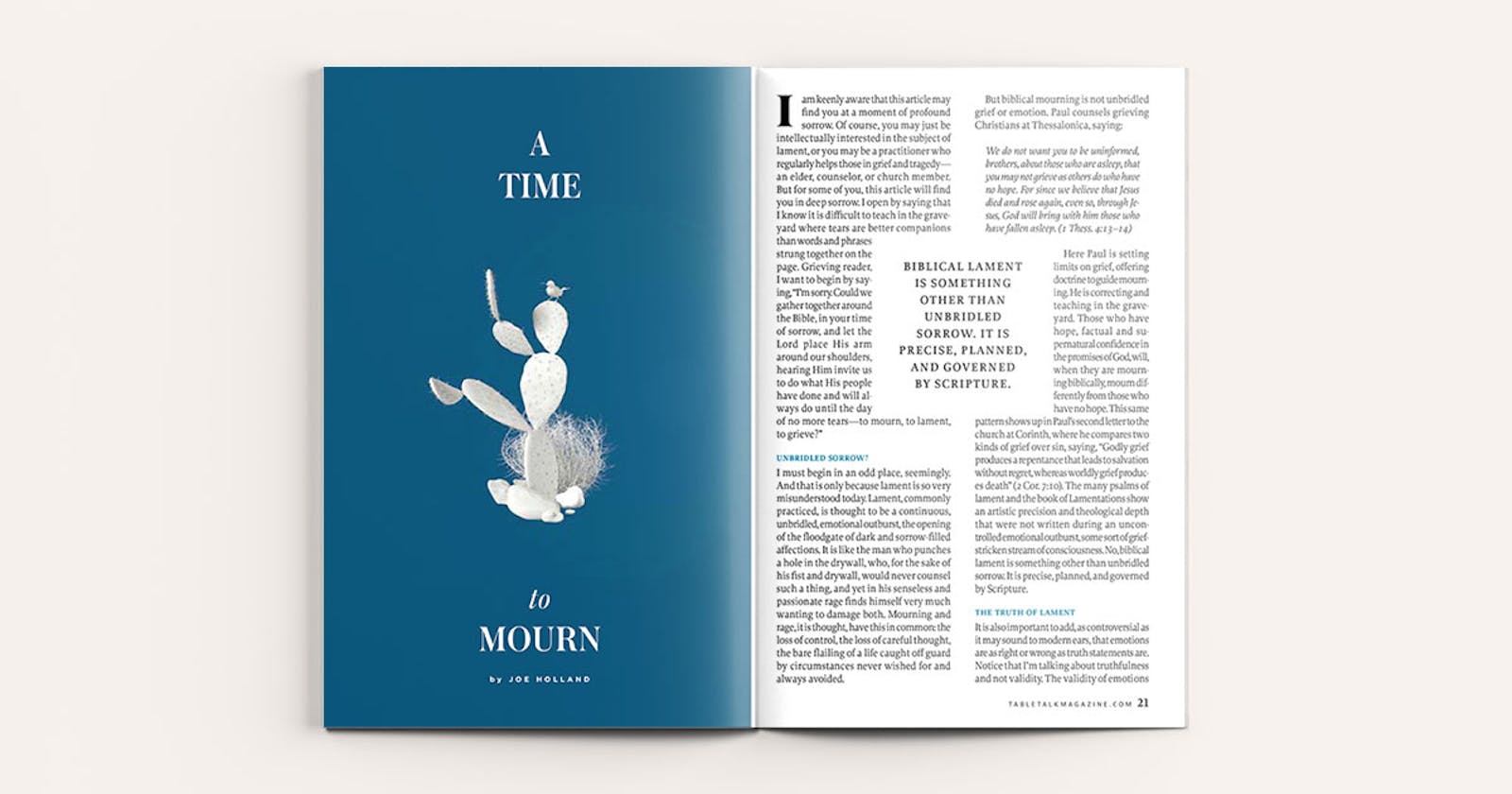
Request your free, three-month trial to Tabletalk magazine. You’ll receive the print issue monthly and gain immediate digital access to decades of archives. This trial is risk-free. No credit card required.
Try Tabletalk NowAlready receive Tabletalk magazine every month?
Verify your email address to gain unlimited access.
I am keenly aware that this article may find you at a moment of profound sorrow. Of course, you may just be intellectually interested in the subject of lament, or you may be a practitioner who regularly helps those in grief and tragedy—an elder, counselor, or church member. But for some of you, this article will find you in deep sorrow. I open by saying that I know it is difficult to teach in the graveyard where tears are better companions than words and phrases strung together on the page. Grieving reader, I want to begin by saying, “I’m sorry. Could we gather together around the Bible, in your time of sorrow, and let the Lord place His arm around our shoulders, hearing Him invite us to do what His people have done and will always do until the day of no more tears—to mourn, to lament, to grieve?”
Unbridled Sorrow?
I must begin in an odd place, seemingly. And that is only because lament is so very misunderstood today. Lament, commonly practiced, is thought to be a continuous, unbridled, emotional outburst, the opening of the floodgate of dark and sorrow-filled affections. It is like the man who punches a hole in the drywall, who, for the sake of his fist and drywall, would never counsel such a thing, and yet in his senseless and passionate rage finds himself very much wanting to damage both. Mourning and rage, it is thought, have this in common: the loss of control, the loss of careful thought, the bare flailing of a life caught off guard by circumstances never wished for and always avoided.
But biblical mourning is not unbridled grief or emotion. Paul counsels grieving Christians at Thessalonica, saying:
We do not want you to be uninformed, brothers, about those who are asleep, that you may not grieve as others do who have no hope. For since we believe that Jesus died and rose again, even so, through Jesus, God will bring with him those who have fallen asleep. (1 Thess. 4:13–14)
Here Paul is setting limits on grief, offering doctrine to guide mourning. He is correcting and teaching in the graveyard. Those who have hope, factual and supernatural confidence in the promises of God, will, when they are mourning biblically, mourn differently from those who have no hope. This same pattern shows up in Paul’s second letter to the church at Corinth, where he compares two kinds of grief over sin, saying, “Godly grief produces a repentance that leads to salvation without regret, whereas worldly grief produces death” (2 Cor. 7:10). The many psalms of lament and the book of Lamentations show an artistic precision and theological depth that were not written during an uncontrolled emotional outburst, some sort of grief-stricken stream of consciousness. No, biblical lament is something other than unbridled sorrow. It is precise, planned, and governed by Scripture.
The Truth of Lament
It is also important to add, as controversial as it may sound to modern ears, that emotions are as right or wrong as truth statements are. Notice that I’m talking about truthfulness and not validity. The validity of emotions comes from our being creatures created to feel deeply and yet also being creatures that are finite and fallen. An emotionless person is a strange and obtuse anomaly. Someone may have a valid emotion to perplexing circumstances that, after time, becomes an altogether different emotion. For example, the response to someone who has died young may begin with the emotion of anger at a life cut short but then, over time, settles into the emotion of gratitude for the years enjoyed with that person. Those emotions of anger and eventual thanksgiving are equally valid, though ultimately, thanksgiving is a more appropriate emotion to express to a God who does all things well, who cuts no life short nor extends one too long. And so we see that validity and truth are different things. We are made to feel, immediately and often. But we may find that a particular feeling was altogether misguided, inappropriate, or wrong after the passage of time brings greater clarity.
Which brings me back to my statement that emotions are either true or false. We may call an emotion wrong. Paul instructs the Christians at Rome to “rejoice with those who rejoice, weep with those who weep” (Rom. 12:15). That would seem odd counsel if all emotions were free from judgment, were amoral in their expression. But how many of us know the temptation to mourn when someone else celebrates the promotion at work that we wanted? How many of us know the temptation to rejoice at the misfortune of others whom we despise secretly, or even not so secretly? And to this, we must add this last thought, that we are meaning-attaching creatures. We do not merely watch life go by. We attach meaning, assigning to life events the appropriate categories of good, bad, righteous, evil, beautiful, ugly, sinful, or holy. Our emotional lives, like our intellectual lives, are our attempt to assign truth to life’s events. And our God of truth, who calls us to be His truth-telling people, has given us emotions to be assigned with precision to all of the events that make up each of our lives. To be more specific and limit the scope of this discussion to the topic at hand, lament is not just a valid emotion but should be a truthful emotion, assigned according to the Bible’s instruction, designating that which is truly sorrow-filled. Lament is as orthodox or unorthodox as a doctrinal statement.
Do not miss how unusual biblical lament and mourning are in comparison to what passes under those words in our day. Lament is not the unrestrained release of sorrow. Lament is not disheveled and unintelligible. As emotions are either true or false in their expression, so lament cannot be simply the validity of tears whenever they gather at the corner of our eyes. Lament is a gift of God for the people of God, the trailing breadcrumbs of sorrow that lead to the feast of joy.

Our Lamenting Savior
There is no better way to examine Christian lament than to observe lamentation in Christ, that great and perfect man, expressive of deep emotions that were always true and godly. In the narrative of Lazarus’ death and resurrection, we have an instructive example of where and when Jesus displays His deepest emotions. The story comes in three parts: Jesus’ recognition of the death of Lazarus while He is with His disciples, His eventual conversation with Lazarus’ grieving sisters, and then His miraculous raising of Lazarus at the tomb. Contrary to what we might think, Jesus saves the most profound expressions of mourning and lament for the tomb, not for when He first gets the phone call and not for when He is sitting in the waiting room with the grieving family. His lament and mourning—“deeply moved in his spirit and greatly troubled” (John 11:33), “Jesus wept” (v. 35), and “deeply moved again” (v. 38)—occur in between parts two and three of this narrative, after His conversations with Mary and Martha, and they serve as a preface and preparation to His battle with death and certain victory at Lazarus’ tomb.
In his work The Emotional Life of Our Lord, B.B. Warfield shows that Jesus’ lament isn’t a collapsing sniffle of sadness; instead, what the underlying Greek reveals is that Jesus’ tears are a precise and controlled mixture of true sorrow, lament, mourning, grief, and especially anger against death itself.
But the emotion that tore his breast and clamored for utterance was just rage. The expression even of this rage, however, was strongly curbed. . . . John gives us to understand that the external expression of our Lord’s fury was markedly restrained: its manifestation fell far short of its real intensity. . . . The spectacle of the distress of Mary and her companions enraged Jesus because it brought poignantly home to his consciousness the evil of death, its unnaturalness, its “violent tyranny” as Calvin (on verse 38) phrases it. . . . It is death that is the object of his wrath, and behind death him who has the power of death, and whom he has come into the world to destroy. . . . The raising of Lazarus thus becomes, not an isolated marvel, but—as indeed it is presented throughout the whole narrative (compare especially, verses 24–26)—a decisive instance and open symbol of Jesus’ conquest of death and hell.
What Warfield so vividly describes is biblical lament and mourning, intentionally controlled and displayed by Jesus at the grave of His friend. The appropriate biblical emotion of the Messiah to death isn’t resignation or a faux boo-hoo-hoo but the tears of a sorrow-filled wrath that the Conqueror of sin, death, and the devil displayed during His certain and violent assault on the gates of hell. As His followers, we join with Jesus in the same kind of precise and purposeful lament against sin, death, and the work of Satan.
Biblical lament is sorrow and grief mixed with righteous anger and rage. Where our doctrine teaches us that Jesus’ kingdom has been inaugurated but not yet consummated, that tears stream our cheeks today but not in that day (Rev. 21:4), that saints still die a stingless death—when these true doctrines are taught, lament and sorrow join with them, uniting mind and affections, attaching emotional meaning to the ongoing conquest of sin, death, and the devil by King Jesus. We weep in the graveyard now just as sure as we will dance at the resurrection when Jesus returns. But each in its order: the weeping before the laughter, the graveside before the resurrection.
